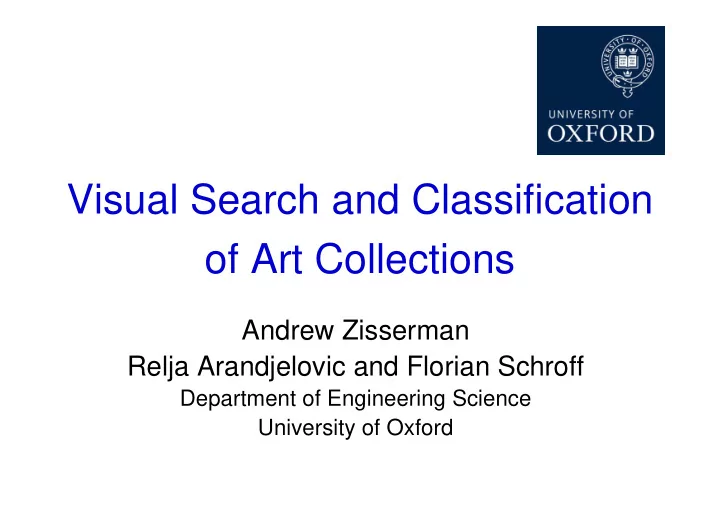

Visual Search and Classification of Art Collections Andrew Zisserman Relja Arandjelovic and Florian Schroff Department of Engineering Science University of Oxford
Given … The Beazley Classical Art Collection at Oxford: • 100K objects (mainly vases) • 120K images of these How can state of the art computer vision algorithms help: art experts? and/or the general public?
The Beazley Classical Art Collection • maintained by experts for many years • wealth of information on each vase • mission statement to make collection available
Two classes of algorithms: 1. Object classification: • Given a photo of any classical vase, classify it into its shape category, e.g. amphora, aryballos, krater ... • Use ‘GrabCut’ of Rother et al for segmentation • Visual descriptor + supervised classification 2. Exact object matching: • Given a photo of a vase in the collection, retrieve information on that vase • Visual google style of Sivic & Zisserman, 2003 • Large scale implementation of Philbin et al, 2007 • Uses visual words to index, affine homography to verify and rank
1. Object (shape) classification
The Objective … • Given a photo of a vase • classify its shape and retrieve similar vases from the archive “It is an amphora … and here are similar Data objects in the archive” What is this? only shape of silhouette used
Shape Representation foreground silhouette original image separation representation vector X 1 X 2 . . . x 2 X n x 1 x • No representation of patterns or surface markings • 100-dimensional “vase shape space”
Shape segmentation - details clamped fg clamped bg 1 st stage of 2 nd stage input segmentation GrabCut of GrabCut
Shape Representation- details silhouette (both sides) handles
Vase shape space
3 nearest neighbour classifier query classify shape all three are neck-amphorae “judge me by the company I keep” “vase shape space” • use random forest of KD trees for approximate NN search
Step by step demonstration: Step 1: upload image URL: http://arthur.robots.ox.ac.uk:8088/
Step by step demonstration: Step 2: classify shape
Step by step demonstration: Step 3: matches in the Beazley archive
Application: check for inconsistent labelling in archive Method: • use each image in turn as a query • determine if predicted shape class matches labelled class Result: there are many mistakes (hundreds)
Compute five nearest neighbours for each vase query consistent labelling all five amphora amphora “judge me by the company I keep” “vase shape space” Require: • five nearest neighbours to have the same label • and to be within a distance of 7000
Mislabelled (about 185) Example
Incompletely labelled (about 82) Example Subclass does not agree
Correcting vase meta-info records • Provided a tool to easily check potentially mislabelled vases • Web-interface to amend shape annotation and correct mis- or incomplete labels • Next: relax strict requirements for inconsistent labeling …
2. Particular object retrieval
The Objective … • Retrieve images from the collection using only visual information • retrieval based on exact match of surface markings and shape ? Visually defined query
Example Search results query ?
Upload query image from file or URL Example Search results query ?
Application: check for duplicate vases in archive Method: • use each image in turn as a query • determine if all the matching vases have the same id Result: there are many duplicates (thousands)
Examples: exact duplicates – same image, different object in database 283 of these
Close ups and sub images (1559 of these) Example 1/3
Close ups and sub images (1559 of these) Example 2/3
Close ups and sub images (1559 of these) Example 3/3
Duplicate candidates (3543) Example 1/6
Duplicate candidates (3543) Example 2/6
Duplicate candidates (3543) Example 3/6
Duplicate candidates (3543) Example 4/6: Not a duplicate Heracles strangling the Nemean lion
Duplicate candidates (3543) Example 5/6: Not a duplicate Frontal chariots
Duplicate candidates (3543) Example 6/6: Not a duplicate Athletes
Summary • Organization of art collections is entirely text based at present • Questions that can be answered effortlessly with CV algorithms: • Is this object already in the archive? • Is this object duplicated in the database (same visual object, more than one entry)? • Is this object consistently classified/tagged? • Futures: • visual merging of two databases • for vases, classification of decorations • also 3D reconstruction
Recommend
More recommend